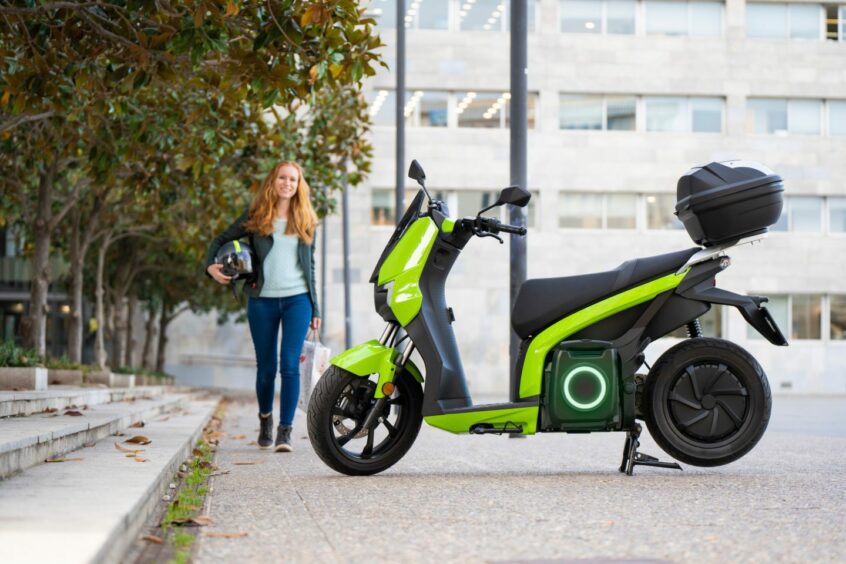Choose the best electric vehicle for your lifestyle and find out about an EV loan here in Scotland that’s available to you.
-
Some Courier online content is funded by outside parties. The revenue from this helps to sustain our independent news gathering. You will always know if you are reading paid-for material as it will be clearly labelled as “Partnership” on the site and on social media channels,
This can take two different forms.
“Presented by”
This means the content has been paid for and produced by the named advertiser.
“In partnership with”
This means the content has been paid for and approved by the named advertiser but written and edited by our own commercial content team.
More people are choosing electric vehicles because they’re cheaper to maintain than petrol or diesel-powered ones. There are also more models available now, catering to different needs and styles. Of course, global concerns over air quality and climate change are also major factors in the switch to electric vehicles.
But if you’re just starting to look at your options in the market, you may run into a bunch of abbreviations and acronyms that are confusing or that don’t make any sense at all.
Here, you’ll find out exactly what an electric vehicle is and find the one that’s best suited for you.
What is an electric vehicle?
An electric vehicle does not require internal combustion engines (ICE) to operate. Instead, it uses an electric motor and a battery pack that can be charged from an external source. This is why it emits low to zero tailpipe carbon dioxide emissions and air pollutants. It also generates less noise pollution.
Types of electric vehicles
Battery-electric vehicle (BEV)
A vehicle powered only by electricity. It’s also known as a ‘pure’ or 100% electric car.
It’s charged at a chargepoint or an external power source. On a full charge, most battery-electric cars have a real-world range of 220 miles.
It does not produce any tailpipe emissions.
Plug-in hybrid electric vehicle (PHEV)
A vehicle that has an electric drive motor, a battery and an internal combustion engine (ICE). That means it can be driven using the ICE or the electric drive motor or both.
It can take petrol or diesel. It can also be recharged from an external power source.
If charged regularly, typical PHEVs are efficient and will have a pure-electric range of up to 50 miles. Once the electric battery is depleted, journeys can continue in hybrid mode.
Extended range electric vehicle (E-REV)
This is a version of a plug-in hybrid vehicle. An E-REV combines an electric drive motor, a battery and a small petrol or diesel generator.
The motor always drives the wheels while the ICE acts as a generator when the battery is depleted.
The range of these vehicles can be between 150 and 300 miles.
Zero emission powered light vehicles (zePLVs)
These vehicles are small, lightweight and energy efficient. They also have zero tailpipe emissions because they’re completely electric.
Great for running errands and commuting, they work well in cities as well as rural areas where public transport is limited.
They can be split into groups called L-categories, depending on number of wheels, maximum weight they can carry and power output.
Electric motorcycles (category L3e)
These are the most common type of zePLV. There are three sub-types according to the power outputs of their engines. That’s measured in cubic capacity (cc) and kilowatt-hour (kW), which influence horsepower and mileage.
-
A1
These are low performance motorcycles or scooters up to 125cc and with 11kW of power output.
-
A2
These are medium performance motorcycles or scooters with up to 35kW of power output.
-
A3
These are high performance motorcycles above 35kW of power output.
These motorcycles can be fitted with an approved sidecar to carry passengers. Riders of electric motorcycles have to wear helmets according to the law.
Electric cycles and mopeds (category L1e)
-
L1e-A powered cycles
These have up to 1kW of power output. They also have two, three or four wheels, cycling pedals as well as power assist, which makes it easier for you to pedal.
-
L1e-B powered two wheelers
These mopeds have up to 50cc, 4kW of power output and a top speed of 28mph.
As with motorcycles, it’s recommended that you wear a helmet when riding these cycles and mopeds.
Electric three-wheeled mopeds (category L2e)
These are designed to carry cargo like work equipment or groceries. You can even use them to take your pet on trips. They can carry a maximum weight of 270kg.
Their power output is limited to 4kW while their maximum speed is 28mph, which is great for cities.
A more powerful version (category L5e) has all the comfort of a small car while letting you get through traffic quickly like a moped does. These can have an excess of 4kW of power output and top speeds that go over 56mph. They can also have up to five seats and can carry up to 1,000kg.
Electric micro cars
With four wheels, these micro cars are great for city driving and can be surprisingly spacious inside. While smaller models might only have one or two seats, bigger models can have up to four seats or two seats plus a cargo area. This is helpful if you’re travelling with someone or need to pick up shopping or carry luggage.
Lower powered versions (category L6e) have top speeds of 28mph, while higher powered versions (category L7e) can travel up to 56mph.
Funding opportunities
Used EV Loan in Scotland
Have you chosen the right electric vehicle for you?
If you’re an individual living in Scotland, Energy Saving Trust can offer you an interest-free loan of up to £30,000 to buy a used electric vehicle from an acceptable dealership. You can repay the loan over five years.
Register and apply for the Used EV Loan in Scotland now.
You should act soon as applications close on November 30 2023.
Domestic chargepoint funding
You can also receive a grant of up to £400 to buy and install home chargepoints for electric vehicles.
Email electricvehiclesscotland@est.org.uk to find out the best route to apply.












